
Dung beetles are beetles that feed on feces. Some species of dung beetles can bury dung 250 times their own mass in one night.

The scarab beetle subfamily Scarabaeinae consists of species collectively called true dung beetles. Most of the beetles of this subfamily feed exclusively on dung. However, some may feed on decomposing matter including carrion, decaying fruits and fungi. Dung beetles can be placed into three structural guilds based on their method of dung processing namely rollers, dwellers and tunnelers Dung removal and burial by dung beetles result in ecological benefits such as soil aeration and fertilization; improved nutrient cycling and uptake by plants, increase in Pasture quality, biological control of pest flies and intestinal parasites and secondary seed dispersal. Well-known members include the genera Scarabaeus and Sisyphus, and Phanaeus vindex.
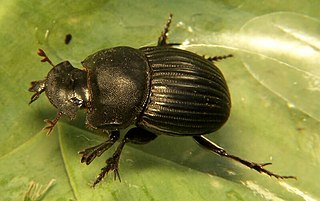
Copris is a genus of dung beetles in the tribe Coprini of the scarab family. It comprises more than 250 tunnelling species and has an almost worldwide distribution.
Amphionthophagus is a subgenus of Scarabaeidae or scarab beetles in the superfamily Scarabaeoidea. It is in the genus Onthophagus.
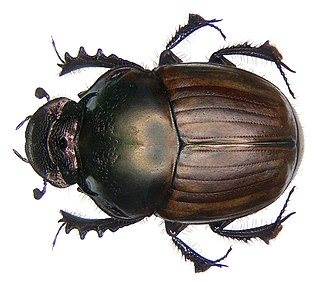
Digitonthophagus is a genus of Scarabaeidae or scarab beetles in the superfamily Scarabaeoidea. It was considered a subgenus of Onthophagus by some authorities. A review of the taxon was published in 2017.

Euoniticellus is a genus of dung beetles in the subfamily Scarabaeinae of the scarab beetle family.
Euonthophagus is a genus of Scarabaeidae or scarab beetles in the superfamily Scarabaeoidea. It was considered a subgenus of Onthophagus by some authorities.

Eurysternus is a genus of Scarabaeinae or dung beetles in the family Scarabaeidae. It is normally placed in the Oniticellini, although some authors consider it the single genus in the tribe Eurysternini (e.g.). It is restricted to the Neotropics and includes 53 recognized species.

Oniticellus is a genus of dung beetles in the subfamily Scarabaeinae of the scarab beetle family.

Onthophagus is a genus of dung beetles in the Onthophagini tribe of the wider scarab beetle family, Scarabaeidae. It is the most species-rich and widespread genus in the subfamily Scarabaeinae, with a global distribution.

Onthophagus gazella is a species of scarab beetle. It belongs to the subgenus Digitonthophagus, which may also be treated as a genus. There has been some confusion regarding the application of the name.
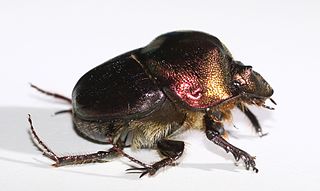
Proagoderus is a genus of Scarabaeidae or scarab beetles in the subfamily Scarabaeinae. It was considered a subgenus of Onthophagus by some authorities. It includes over 100 species native to Africa and Asia.
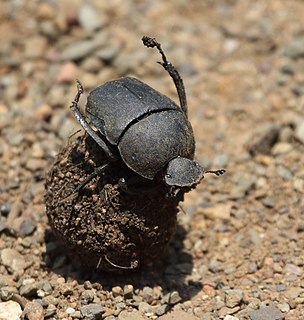
Gymnopleurini is a tribe of scarab beetles, in the dung beetle subfamily (Scarabaeinae), but it may now be combined with the Scarabaeini. The side edge of each elytron has a characteristic shape that exposed the underlying pleural sclerites. Relative to other dung beetles they are of moderate size.

Coprini is a tribe of scarab beetles, in the dung beetle subfamily (Scarabaeinae). Scholtz et al. describe them as tunnellers that are shiny black, of moderate to large size and with a strongly convex shape. They also, however state that the grouping based on these characteristics has little phylogenetic validity, and the placement of several genera in this and related tribes is likely to change.

Metacatharsius is a genus of dung beetles in the tribe Coprini of the scarab family. It comprises more than 60 species from Africa; one is also found in Arabia, and Pakistan.

Liatongus is a genus of dung beetles in the subfamily Scarabaeinae of the scarab beetle family. At least part of the upper surfaces are without hairs; the head and pronotal disc are generally sculptured; and the genae are rounded, with little or no indentation between the clypeus and the genae. Length ranges from 7.4 to 10.9 mm. Colours vary: they may be uniform brown or dull purple, or have red, white or yellow patterns on the elytra.
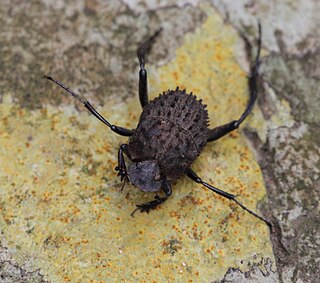
Sisyphini is a tribe of scarab beetles, in the dung beetle subfamily (Scarabaeinae), but it may now be combined with the Scarabaeini. The middle and hind legs are very long; the relatively short body is laterally compressed and has flattened sides. Relative to other dung beetles they are of small to moderate size.

Sarophorus is a genus of dung beetles in the tribe Ateuchini of the family Scarabaeidae. It comprises about ten species from Africa.

Liatongus rhadamistus, or Scaptodera rhadamistus, is a species of dung beetle found in India, Sri Lanka, Laos and Thailand.
Tibiodrepanus is a genus of dung beetles comprising seven species distributed in Oriental and Palaearctic countries.

















